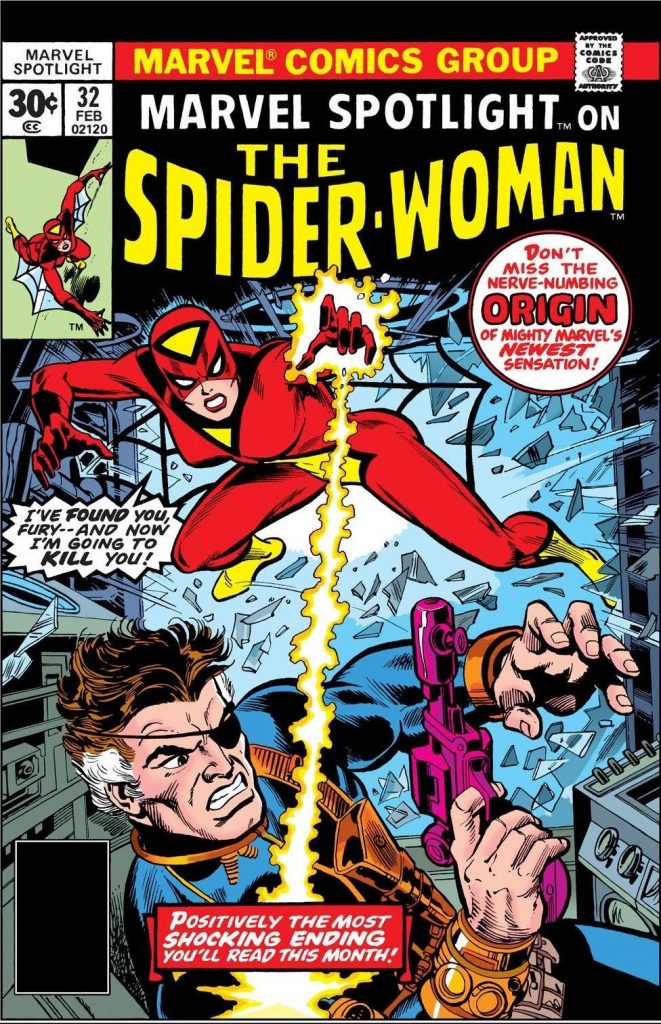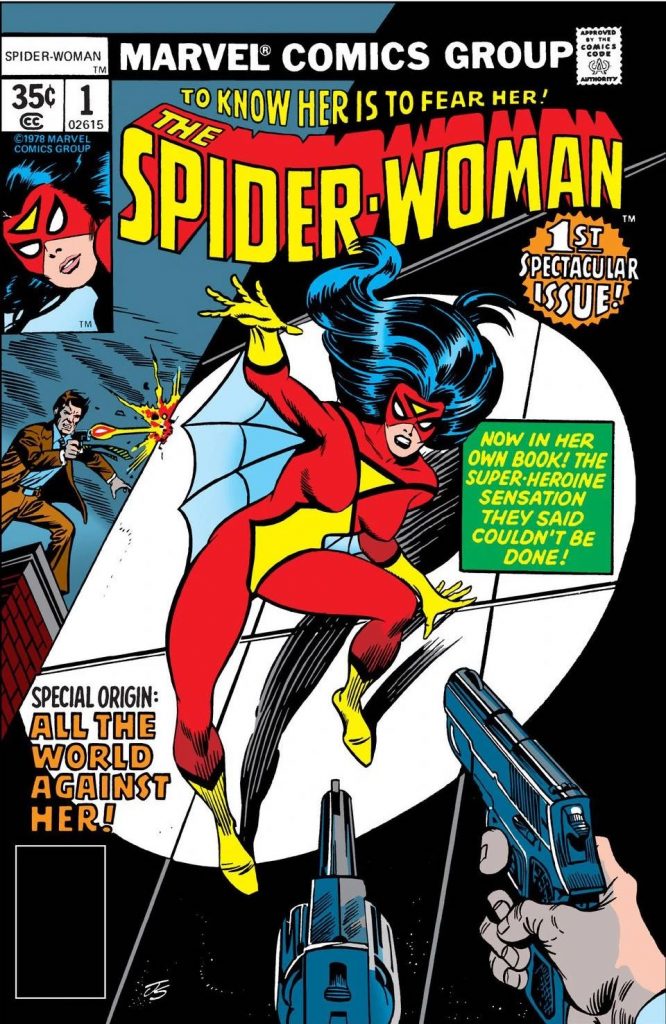Spider-Woman’s origin story begins at Mount Wundagore, the weird, hard-to-explain Marvel Comics locale in Eastern Europe that was home of Herbert Wyndham, the geneticist known as the High Evolutionary, who artificially evolved ordinary animals into sentient semi-humanoids. Wundagore was also frequently by the sorceress Morgan Le Fay and her cult of Darkholders, who, unable to control the Cthulhu-derived Chthon they had summoned, imprisoned him within Wundagore Mountain.
Born the daughter of Merriam Drew and Jonathan Drew, Spider-Woman was thus “conceived” in an environment of a spoonful of genetic experimentation mixed with a dollop of dark sorcery. Jonathan Drew, who was the lab partner of the aforementioned Herbert Wyndham, was desperate to save Jessica, who had became gravely ill from exposure to uranium. To save her life, her father injected her with an experimental serum based on irradiated spider blood. But because the serum required incubation time, Wyndham placed her in a genetic accelerator.
While in the accelerator, she aged at a decelerated rate and, when she is finally released decades later, Drew is only 17 years old and her mother had died long ago, while her father recently murdered under mysterious circumstances in the United States.
When she leaves Wundagore to seek human civilization, she is captured by HYDRA who erase her memories, brainwash her, and recruit her as a HYDRA agent under the codename Arachne.
Spider-Woman’s story picks up in the pages of Marvel Two-in-One, the team-up comic that paired the Fantastic Four’s Thing with another Marvel character. HYDRA agent Jessica Drew is ordered to abduct Alicia Masters, who is vacationing in London. Ben Grimm doesn’t take kindly to the harassment of his girlfriend, so he starts clobbering.
Knocked to her senses, Spider-Woman recovers from her brainwashing and joins Ben Grimm in saving Masters. She and Grimm then encounter Modred the Mystic, who removes HYDRA’s memory implants and restores Jessica’s memories.
That’s all very convoluted, so I must point at that I actually simplified the above to make it easier to soak in. Marvel obviously recognized the labyrinthine nature of it all because they retold Spider-Woman’s story decades later in 2005’s 5-part Spider-Woman: Origin.
Origin does away with the spider-blood serum and genetic accelerator elements of the character’s previous origin story. Instead, Jessica’s powers derive from her mother’s womb being hit by a laser beam containing the DNA traits of several different species of spiders.
Then, after Jessica’s parents disappear under mysterious circumstances, Jessica is recruited into HYDRA , where she is trained into a formidable fighter and assassin by Taskmaster.
As an aside, if you want to understand the difference between the compressed storytelling of older comics and the decompressed storytelling of modern comics, Spider-Woman: Origin is a perfect example, which is pitched as a “streamlined” story, yet is largely a retelling of Marvel Spotlight 32, told in 5 issues instead of the 1.
But none of that is Spider-Woman’s true origin story at all. Let’s hear Spider-Woman’s true origin story from Stan Lee himself:
“I suddenly realized that some other company may quickly put out a book like that and claim they have the right to use the name, and I thought we’d better do it real fast to copyright the name. So we just batted one quickly, and that’s exactly what happened. I wanted to protect the name, because it’s the type of thing [where] someone else might say, ‘Hey, why don’t we put out a Spider-Woman; they can’t stop us.’ … You know, years ago we brought out Wonder Man, and [DC Comics] sued us because they had Wonder Woman, and… I said okay, I’ll discontinue Wonder Man. And all of a sudden they’ve got Power Girl [after Marvel had introduced Power Man]. Oh, boy. How unfair.”
– Stan Lee
So, Spider-Woman was hastily created to secure intellectual property rights. That checks out.
It was Archie Goodwin who created the basic character outline you read above, but it was freelancer Marie Severin who designed the appearance of Spider-Woman.
I am an avowed Marie Severin fan, as she drew many of my favorite Marvel covers from the 1970s. Severin initial look for Spider-Woman was immediately iconic, the only change made by regular series artist Carmine Infantino was to remove her skullcap to allow her long black hair to flow out. But Severin’s lines and colors remained exactly as they were during creation.
Spider-Woman next costume change didn’t come until 35 years later, an uninspired look of luuulemon leggings paired with Oakley sunglasses.
Spider-Woman Solo Series
While Spider-Woman’s origin story was told in Marvel Spotlight and Marvel Two-in-One, it wasn’t long until Jessica Drew received a solo series. Marvel Wolfman was the initial writer of the title but admitted: “If truth be told, I never felt comfortable writing her. I never found a handle for her and kept trying until I finally decided to leave the book”.
Those early Wolfman Spider-Woman stories featured a gothic tone that emanated from the establishment of Morgan le Fay and the Brothers Grimm as her arch nemeses and an unclear narrative around how her power worked. Spider-Woman’s pheromone powers weren’t defined at this point, with the narrative simply being that she made people feel weird and mistrustful of her.
Comics legend Carmine Infantino stayed on as penciler while the venerable Mark Gruenwald took over writing duties. Meanwhile, an animated Spider-Woman series debuted where Jessica Drew was voiced by soap opera legend Joan van Ark. The cartoon didn’t resemble the comic storylines whatsoever, although it kept Severin’s iconic look for the character. (The Spider-Woman cartoon incidentally is available on Disney+.)
Issue #20 saw the departure of Gruenwald and Infantino, as well as the cancellation of the cartoon after 1 season. . New writer Michael Fleisher gave Spider-Woman a career as a bounty hunter and abandoned both the comic’s macabre tone. But in 32 Chris Claremont took over and switched Jessica Drew’s occupation from bounty hunter to private investigator.
The series was cancelled at issue 50 with Jessica Drew being killed off by writer Ann Nocenti in a climactic battle with her nemesis Morgan le Fay. Interestingly, the final issue used a photo cover of Marvel staffers (including Gruenwald and Nocenti) in costume as the comic book’s cast.
Less than a year after her death, Spider-Woman was resurrected in The Avengers #240-241 but wasn’t seen much in comics. In fact, the Secret Wars crossover introduced a brand new Spider-Woman, Julia Carpenter, created in order to have a another character alongside Spider-Man in his new black suit.
But Claremont used Jessica Drew several year after her series cancellation in the Wolverine solo series, although Jessica was never in costume in those appearances. Jessica Drew wasn’t back in costume until 2005 in Brian Michael Bendis’ New Avengers title. By that time Spider-Woman was so off the radar the Spider-Woman: Origin was required to re-introduce the character to a new generation of comic readers.
If you need additional evidence of how little Marvel thinks of the character, the entire comic run isn’t even available on Marvel Unlimited. They do a few issues and then it’s as if, eh, that’s enough of this character.
Me? I’ve always liked Spider-Woman. While I vaguely remember the cartoon as a kid, I wasn’t really introduced to Jessica Drew until the Wolverine solo series, at which point I was hooked. Bendis’ use of her in New Avengers was excellent also.
It was at that point that I revisited the original solo series and was able to appreciate it it for what it was: An uneven series that nevertheless established a wonderful character, despite a convoluted origin story.
Lessons Learned?
- Sometimes you engage in creative work because you feel like you need to, but you get started and figure it out as you go.
- But sometimes your first draft is nearly perfect, like in the case of Marie Severin’s initial character design.
- Nearly every character element introduced by Chris Claremont is enduring.
- Mount Wundagore is weird, so if we do see it later the the MCU, buckle up.



